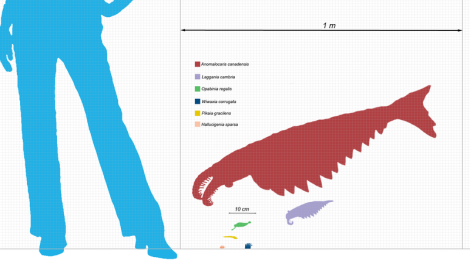Anomalocaris really does know how it feels to be a bit of an anomaly… and he’s not the only one.
Many moons ago railroad workers in the Canadian Rockies took time off from amusing themselves by freezing off various body parts and instead took to finding some rather amusing shaped rocks. When word of the stony-bugs from the back of beyond reached the palaeontologist Charles Doolittle Walcott he went to take a looksy for himself. There the esteemed gent found some of the most remarkable curiosities in a marvellous state of preservation; there were even squishy creatures in the fossil beds.
Such wibbly bits are very rarely preserved and so when Charles first found a jellyfish that seemed to be tussling with a prawn he could do little else but marvel upon it and place it lovingly with the other sixty five thousand specimens he’d been working on.
Charles returned the next year, and the proceeding year after that… oh… and for the next twenty-three years, tirelessly describing these fossils of the Burgess shale. He toiled away meticulously describing the stone bugs, crow-barring the fossils into the families of existing animals, before finally passing away three years later at the ripe old age of seventy seven. Though he passed peacefully it was a tragic death, like an impoverished artist he died without realising the true worth of his toils.
Other palaeontologists found sponges, in the vicinity of other specimens of the prawns and jellyfish first described by Mr Walcott Esq. Soon it became clear that these weren’t ancient sea creatures having a salty shindig… they were in fact one creature… the jellyfish is in fact a mouth, those prawns were graspers, the sponge would have been abominable at bath-time and was actually a body… it was in fact a relatively huge predator from the Cambrian period.
As more recent learned types have poured over Walcott’s specimens from the Burgess shale they’ve begun to realize just how remarkable they are. These aren’t ancient shrimp, odd old jellyfish and wormy ancestors. They are a cornucopia of creatures that have no relatives left, odd little thingamujigs that we have nothing left on the planet to even vaguely compare them to. Not only that but these creatures have re-evaluated how we look at these extinct creatures… the tree of life isn’t a small sapling with a few families branching out here and there… it is a magnificent oak with huge branches reaching out. Somewhere near the top is an unremarkable branch, just a tiny fraction of the size of the whole tree, and every single one of the millions upon millions of animals that live on our planet is represented by this simple bough… and all the sprigs below it have fallen… and each tiny twig on every single branch a little anomaly… just like the odd little shrimp from a set of fossils that redefined the tree of life.




